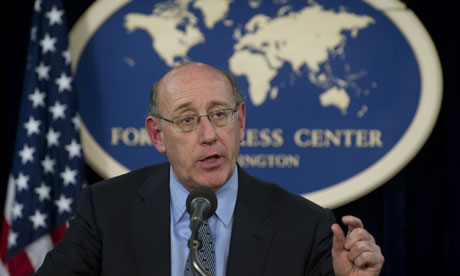
Nearly a year after the oil disaster began, Gulf Coast residents are sick, and dying from BP's toxic chemicals.
BP's oil disaster last summer gushed at least 4.9 million barrels of oil into the Gulf of Mexico, causing the largest accidental marine oil spill in history - and the largest environmental disaster in US history. Compounding the problem, BP has admitted to using at least 1.9 million gallons toxic dispersants, including one chemical that has been banned in the UK.
According to chemist Bob Naman, these chemicals create an even more toxic substance when mixed with crude oil. Naman, who works at the Analytical Chemical Testing Lab in Mobile, Alabama, has been carrying out studies to search for the chemical markers of the dispersants BP used to both sink and break up its oil.

 Environmental Glance
Environmental Glance When Benjamin Grumbles was assistant administrator for water at the Environmental Protection Agency in the George W. Bush administration, he oversaw the release of a 2004 EPA report that determined that hydraulic fracturing was safe for drinking water.
When Benjamin Grumbles was assistant administrator for water at the Environmental Protection Agency in the George W. Bush administration, he oversaw the release of a 2004 EPA report that determined that hydraulic fracturing was safe for drinking water. At the end of "Erin Brockovich," a housewife sick from toxic chromium weeps with joy as she's handed her portion of a historic $333 million settlement between residents of this small desert town and the utility that poisoned their drinking water.
At the end of "Erin Brockovich," a housewife sick from toxic chromium weeps with joy as she's handed her portion of a historic $333 million settlement between residents of this small desert town and the utility that poisoned their drinking water. U.S. District Court Judge H. Russel Holland ruled Monday against a request that he force Exxon Mobil Corp. to pay for the cleanup of oil left on the Prince William Sound shoreline from the 1989 tanker Valdez spill.
U.S. District Court Judge H. Russel Holland ruled Monday against a request that he force Exxon Mobil Corp. to pay for the cleanup of oil left on the Prince William Sound shoreline from the 1989 tanker Valdez spill. The cost of our success is the exhaustion of natural resources, leading to energy crises, climate change, pollution and the destruction of our habitat. If you exhaust natural resources there will be nothing left for your children. If we continue in the same direction, humankind is headed for some frightful ordeals, if not extinction.
The cost of our success is the exhaustion of natural resources, leading to energy crises, climate change, pollution and the destruction of our habitat. If you exhaust natural resources there will be nothing left for your children. If we continue in the same direction, humankind is headed for some frightful ordeals, if not extinction. Upwards of 100,000 claims arising from the BP oil disaster in the Gulf of Mexico may never be paid, the beleaguered administrator of the oil company's compensation fund has acknowledged.
Upwards of 100,000 claims arising from the BP oil disaster in the Gulf of Mexico may never be paid, the beleaguered administrator of the oil company's compensation fund has acknowledged. The American landscape is dotted with hundreds of thousands of new wells and thousands of drilling rigs, as the country scrambles to tap into this century’s gold rush — for natural gas.
The American landscape is dotted with hundreds of thousands of new wells and thousands of drilling rigs, as the country scrambles to tap into this century’s gold rush — for natural gas.






























